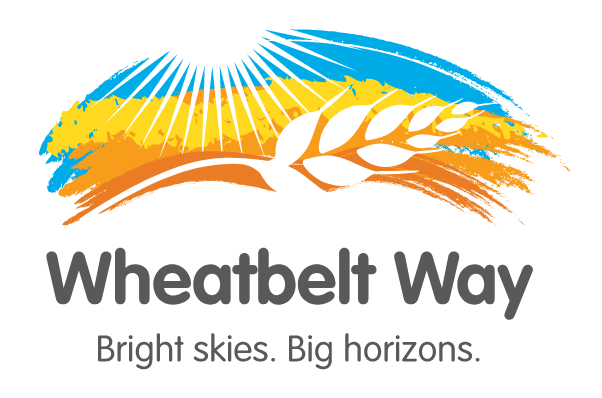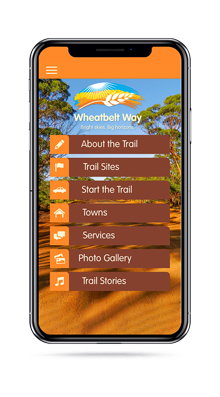Trail Sites
The Wheatbelt Way Drive Trail has 24 key interpretative sites spanning along the 800km road trip. Open roads stretch through wide open country, where far horizons reveal hidden surprises. The area boasts a rich and extensive history, charming and friendly people, and a truly Australian landscape.
Wheatbelt Way Drive Trail Audio Stories
The Wheatbelt Way Audio Stories is a collection and the telling of the region’s history, events, and attractions through the gathering of interviews from identified local identities or the narration of written history and stories, in a manner that may be of interest to both locals and visitors alike. It is the perfect audio guide to your Wheatbelt Way road trip.
Trail Site Information
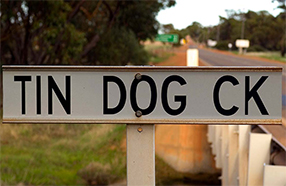
In the late 1800’s as miners were heading to the Yilgarn Goldfields, this creek was used as a resting place for the men and their horses. They called their tinned beef ‘tinned dog’, presumably because of the taste, and many years later these cans can still be seen scattered in the bush as you walk along the trails. There are two circular walking trails, one 3.3kms and the other 1.8kms in length which can be accessed from the information bay parking area opposite Rusty, the tin dog. Look for western grey kangaroos, goannas, red-tailed cockatoos and echidnas as you walk.
In 2003 the students of Dowerin District High School were looking for a project for the town and came up with the idea of Rusty, the tin dog. They received a grant to enable them to use the services of a sculptor to help them. Rusty now stands on Goomalling Road with his paw lifted showing the way to the information area and Dowerin’s main street.
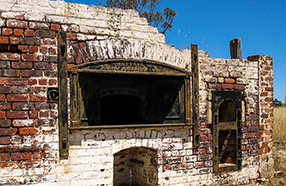
This tiny town occupies an area formerly known as 36 Mile Post on the Rabbit Proof Fence. This was also where a railway siding was built in 1911 on the railway line heading east to Bencubbin that supported the early settlers of the district with supplies and transport.
Driving through the town of Minnivale today you will see the brick store built in 1921 still displaying advertisements of long ago, the remains of the farmer’s co-op and post office minus a section of veranda built in 1919. This building was the hub of the town in its early days with most people getting their supplies through mail order catalogues and the co-op supplying fresh groceries.
The Methodist Church was built by brick in 1925 and is now a tribute to the pioneers of the district. A concrete floor is all that remains of the garage business. A bakery oven and a few remaining houses are still there today.
A modern wheat silo and facilities were constructed in 1963 to replace the original facility that had been built in time for the 1933-34 harvest, although it is no longer used to store wheat. Minnivale will soon become home to the Wheatbelt Rail Heritage Project where firstly the S Class “Greenmount” locomotive will be relocated, complete with passenger carriages, a dining carriage, guard vans and other items of rolling stock. These will form part of a permanent fully interpretative static display “The Wheatbelt Rail Heritage Museum” – annex to the Bassendean Rail Heritage Museum.
Visitors to Minnivale will find a camping and rest areas with toilets, showers, water and a dump point.
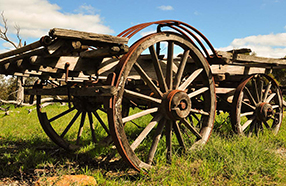
Located east of Dowerin, just off the Goomalling-Merredin Road, Naaning Well site was significant for supplying water to gold seekers on the goldfields track to the Yilgarn Goldfield in the late 1800’s.
Nenin Well, Naaning Well and Yarragin Homestead were commissioned by the Toodyay Road Board in 1869.The first payable discovery of gold in the Yilgarn was by prospectors Greaves, Payne and Anstey in 1887 at Eenuin and subsequently at Golden Valley north of present Bullfinch. It was these finds that began the rush and on the 1st October 1988 the Yilgarn Goldfield was declared. The quickest way to reach Yilgarn from Perth at this time was by rail to Northam and then by road to Goomalling and finally east along the Yarragin Road.
Gold seekers trekked along the Yarragin Road, camping at the wells and homesteads as designated by a map provided to them that was published to provide prospectors with details of water and provisions. By 1889 inns had been established at Goomalling, Mangowine and Yarragin. In 1892, with the Coolgardie goldrush the focus turned to rail transport and the Yarragin route was all but abandoned.
The purpose of the Reserve was changed to protection of flora in 2000, at which time it was vested in the Shire of Dowerin. Naaning Well, well worth a visit, is significant for the associations with early explorers, surveyors and gold seekers on the goldfields track to the Yilgarn Goldfield. It has picnic facilities, toilets, and a walk trail.
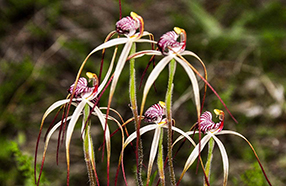
Korrelocking Reserve consists of an area of 259ha of pristine bushland 7km east of Wyalkatchem and can be accessed via two roads; Goldfields Road and Tyler Road, which cuts the reserve diagonally from northwest to southeast.
The reserve lies in gently undulating cleared farmland, the only exception being a small area of jam woodland used by stock for shelter and grazing on the north-eastern corner. Some of the best Salmon Gums and Gimlets to be seen in the Wyalkatchem Shire can be seen in the reserve. As well as being a sanctuary for kangaroos and other forms of animal life indigenous to this part of the Wheatbelt, forty-four bird species have been recorded on Korrelocking, the highest number of species recorded on a nature reserve within this Shire. Six of these include: the Pacific Heron, Black-shouldered Kite, Whistling Kite, Little Eagle, Black-tailed native-hen and Long-billed Corella, all of which have not been recorded on any other nature reserve in the Shire.
The reserve is a popular spot for picnicking, especially during spring when the wildflowers are in full bloom. There is also a pioneer well a short walk from the car park. It has tables, interpretative signage and a clearly marked walk trail as well as a toilet. Dogs are not allowed.
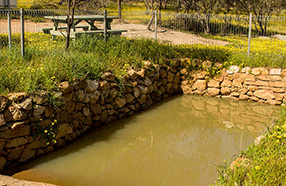
Wyalkatchem Well, otherwise known as Wyalkatchem tank due to it being uniquely rectangular in form with sloped granite sides to create a stone tank, was constructed by John Haywood for the Toodyay Roads Board in 1881. Haywood was an expiree who farmed at Toodyay.
Wyalkatchem Well is located 10 meters from the south side of the Wyalkatchem-Koorda Road within the Wyalkatchem Golf Course. It was originally gazetted in 1884 as a stopping place for teams. The tank is of stone construction that is regular in form and size. On the north side of the tank extensive sheets of granite adjoin a creek. The tank is approximately 5 metres wide and 7-8 metres long.
In 1915 the reserve was vested in the minister for Railways as a railway water supply. In 1917 the Chief Engineer of Railways wanted the Wyalkatchem Well closed to prevent teamsters and stock from polluting water running into the railway dam. Steam locomotives required high quality water for their boilers.
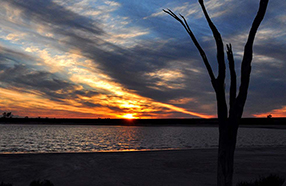
Cowcowing townsite originated as a railway siding and was gazetted in 1919. However the town is long gone and all that remains is the CBH Wheatbin and Cowcowing Cemetery, located 4km a further 4km north of the townsite.
Cowcowing Lakes is a large tract of land that is primarily a dry saltpan surrounded by dense salt-tolerant plants. The lake goes through a cycle of being wet for part of the year and then to either a salt crust or dusty plain as the lake dries out in the summer months. A natural function of all wetlands and lakes is to act as conduits returning salts deposited by rainfall, back to the ocean. At times the movement of salts by human standards is slow, and the wetlands often serve as temporary storage or reservoirs of salt. When full, it covers an area of around 15,000 hectares and is located north of Wyalkatchem on the way to Koorda.
The name of the town is Aboriginal in origin and was first recorded by explorers in 1854. The name of the nearby lake, originally recorded as Gow gow eeh lake, has now been renamed Cowcowing Lake. The meaning of the name remains unknown.
The cemetery is the final resting place for the many of the early pioneering families and will be fascinating to anyone with an interest in the early history of the region. The site is well worth a stop and a leisurely stroll around the cemetery to pay homage to the earlier settlers and to see an insight into the hardships of early life in the Wheatbelt.
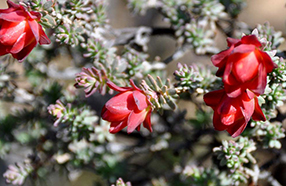
The Koorda Native Flora Reserve is located 16km north of the town on the Mulji Road. Numerous species of flora native to the area are on display and offer the ideal setting for a leisurely stroll along the guided walk trail.
Colourful flowering shrubs and wildflowers are a blaze of glory for many months of the year. Probably the most luxurious displays are the Everlastings, for their brief flowering period, and the various types of yellow and pink Verticordia species, with especially brilliant Dampiera species also being found in the area. Wattles, Bottlebrush and various types of Cassia line many roads in the spring time.
The small red Darwinia Rosea, which is plentiful in the area, is commonly called the “Koorda Rose”. Probably another fifty to sixty species can readily be found during their flowering periods, particularly between July and October.
Great picnicking facilities are at this 28ha site with BBQ’s, tables, interpreted signage and a toilet.
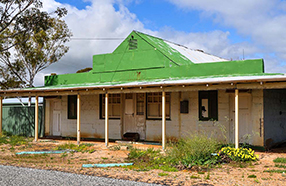
Gabbin is located in the eastern agricultural area of the Wheatbelt about 17 km west of Bencubbin. When the railway line from Wyalkatchem to Mount Marshall was proposed to be constructed through this area in 1913 the need for a station place was identified. Gabbin was approved as the name of the station by the Minister for Lands in 1914, and it was derived from “Gabbabin”, a place located about 10 km southeast of the townsite which was first shown on maps in 1909. The town site, gazetted in 1918, was named after the railway station.
Agriculturally the land around Gabbin was opened for selection in 1910. Living conditions for these pioneers involved living in a tent until a ‘humpy’ was built. Most Humpy’s were a simple timber frame with earth floors that were covered with hessian bags. Hessian was also sewn together and starched with a form of plaster to make the walls and corrugated sheets of tin covered the roof. The humpy’s were very hot in summer and cold in winter and all the cooking was done outside. Kerosene was used to soak the wicks used for burning in lights and water was heated using a copper or by filling empty 20 litre kerosene tins with water and placing on the fire.
Come have a look at the small pioneering town of Gabbin and enjoy its heritage walk trail, however there are no services remaining in the town such as fuel. Gabbin is one of many smaller towns in the Wheatbelt that has slowly disappeared as a result of improved farming methods, population decline and more efficient methods of transport.
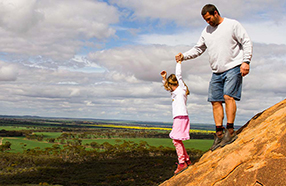
A favourite leisure spot for locals, Marshall Rock has been the location for many community barbeques and picnics dating back as far as 1913. The reserve remains a great place for bushwalking, bird watching and viewing the wildflowers. One of the best reasons to visit the site has to be the spectacular views from the top of Marshall Rock where one can see Lake McDermott, vast agricultural lands and even the Bencubbin Wheatbins. The Reserve covers 1.4 square kilometres and is bounded by private farming land on every side.
The Rock was found in 1836 by Surveyor General John Septimus Roe. Marshall Rock was named after Captain Marshall McDermott who was an early settler on the Swan River colony. It is a great spot for camping with picnic with tables, shelter, fire pits and a waterless toilet all available.
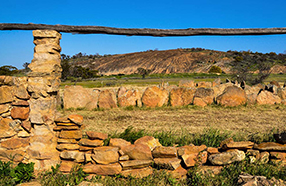
For a trip back in time, a visit to Pergande Sheep Yards is a must. Located at the site are the remains of an original and prominent homestead and sheep yards that were constructed almost entirely from local granite. The sheep yards are made from large granite slabs that were drawn into position by horse sled from the nearby Wiacubbing Hill. These slabs were then placed upright out of the ground to make the fences of the sheep yards. The homestead was constructed using smaller round rocks held together by mortar.
Given the historical and cultural importance of the site, it has been made available for visitors and the general public to access. The site is located on the property of Murray and Donna Cooper, approximately 10kms from Bencubbin. Readings at the site of the original farm owner, Edward (Ted) Pergande will prove fascinating. Ted and his wife Annie were prominent local figures who contributed greatly to the development of the area.
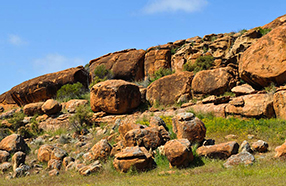
Billiburning Rock was surveyed by Harry Sanford King around 1889 and the rock itself is part of quite a large reserve. It has attractive flora and fauna, fantastic views from the top, and is a pleasant place to picnic or camp. Billiburning also offers many memorable photograph opportunities. Located on the reserve are a gnamma hole and a soak which are easily accessible.
Billiburning Reserve is located towards the northern end of the Mt Marshall Shire. The northern end of the reserve backs onto the vermin proof fence which separates Billiburning Reserve from the Karroun Hill Nature Reserve. The vermin proof fence was built in the 1950’s to keep the emu’s, goats and wild dogs out of the farming area. Despite not having a 100% success rate, the fence proved to be a success.
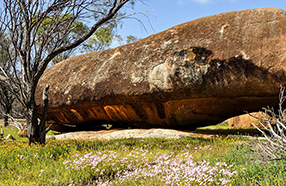
Datjoin Well and Rock reserve has several unique rock formations located east of Beacon, an area opened to pastoral leases as far north as Datjoin in 1872 and the well was dug in early 1900’s by sandalwood cutters.
During the winter and spring months of July to October Datjoin Reserve is a popular picnic and tourist camp spot for travellers as well as those looking to find some of the best orchids and wildflowers the region has to offer. Beacon locals also frequent the area, having enjoyed many years of picnicking and socialising in years past at Datjoin. Datjoin had a brief brush with the law back in 1971 when lionel Brockman, an aboriginal West Australian, escaped from Woorooloo Prision and used the reserve as a hideout for him, his wife and 12 of their children.
Travel 18kms east of Beacon on Burakin/Wialki Road to the narrow track entrance to the Datjoin Well and camping areas, accessible to cars/4wds/camper trailers only, no caravans. Camp fires allowed April — September. Access to Datjoin Rock is another 2 kms eastwards on Clark Rd on the left at the top of the rise. No access to large vans. Track into Datjoin is ok for 2WD vehicles and camping is allowed for camper trailers and tents.
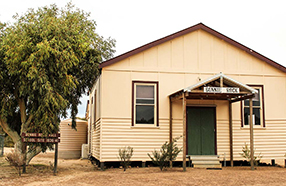
Bonnie Rock is a townsite on the edge of the Eastern Wheatbelt, and was the terminus of the railway line through Beacon. The townsite was gazetted in 1932, its lateness due to the land around Bonnie Rock not being surveyed until 1928-29. The name was suggested by the district Surveyor, S Smith, in 1930 and was taken from a nearby rock.
The Bonnie Rock district was at its peak in 1934-35 with 119 ratepayers, two shops, a butcher, garage, a boarding house, railway and a large area cleared for a sports ground . By 1944, after a series of droughts and the Depression, there was no Bonnie Rock townsite as the ratepayers left and the only remaining building was the Town Hall. By 1949 there was only 29 ratepayers left in the district. The Town Hall still stands today and is used by the community as well as the sports area by the Bonnie Rock Horse and Pony Club.
Bonnie Rock is in the vicinity of Berinbooding Rock and Elachbutting Rock. It offers travellers a place to stop and rest on the way to these attractions. Ample sign posting indicates where the original streets were, with the main street being lined with the lot numbers of original owners.
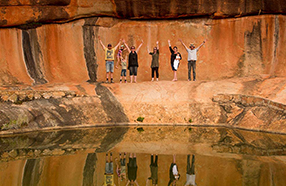
Beringbooding Rock has the largest rock water catchment tank in Australia, built-in 1937 and holding two and a quarter million gallons. “Sustenance Labour” was used to build the tank at a cost of 10,000 pounds. Beringbooding also has an amazing balance boulder, a huge gnamma hole, and some of the Kalamaia tribes’ paintings of hands in a cave at the rear of the rock. Two early pioneer wells are also located nearby.
Spring finds the pink ti-tree, heart-shaped leaf eucalyptus melaleuca, acacia, grevillea, hakea, calothamnus, eromophilia, cassia, quandongs, sandalwood, and the native orchids flowering. Later into October and November the Kunzia Pulchella and one-sided bottlebrush flower profusely and many birds inhabit the area. Well worth a visit by anybody in the area.
Beringbooding Rock has great picnic and free camping facilities with easy caravan access, picnic tables, BBQs, a toilet, interpretative signage, and a marked walk trail.
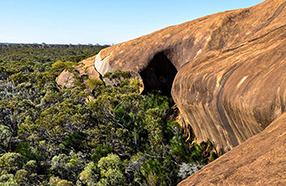
Elachbutting Rock is a massive granite outcrop, a very popular camping spot for 4×4 wheel clubs and for locals, as well as a popular site for weddings. The name Elachbutting is thought to mean ‘big things standing’ which is quite feasible as Elachbutting is a large granite rock and a prominent landmark standing out from the surrounding countryside with excellent views from the top . It has a spectacular colorful rainbow wave similar to Hyden’s Wave Rock with the added beauty of ‘Monty’s Pass’, a 30m tunnel caused by a rock slide. An echoing cave, “Kings Cave”, similar to an amphitheatre is close by. The 6km track around the rock with its dense trees and shrubs hide many interesting species of flora. The east side is renowned for its masses of Donkey Orchids at the base to the rock in a wet year.
An excellent place to camp with barbeques, picnic tables and a toilet, Elachbutting has a reputation for being bigger, better and more pristine than any Wheatbelt granite rock formation that you may have seen before. The rock is around 100km north of Westonia and is easily accessed via well maintained gravel roads. Visitors are encouraged to take all they need for a day trip and then take all they took home with them again. Dogs are not allowed.
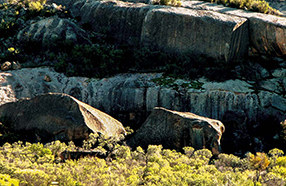
Sandford Rocks Nature Reserve is another great place to get close to nature in the Wheatbelt. This idyllic reserve contains a complex mosaic of exposed granite rock, with surrounding shrublands and woodlands.
The reserve protects an area of 805.9 hectares, consisting of granite rock, thickets and woodlands. It is best accessed from the nearby town of Westonia. The reserve also has an excellent range of picnic facilities and amenities, although no camping or dogs are allowed.
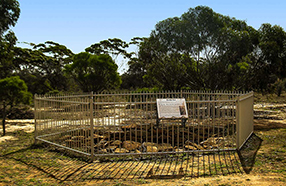
Boodalin Soak is located approximately 6kms west of Westonia, just off Stoneman Road. The soak is within the Westonia Common which consists of 5600ha of Salmon Gum, Morrell and Gimlet woodland. Also known as Bodalin Well, it was one of a series of dams and wells sunk by early explorer and Government Surveyor CC (Charles) Hunt in 1865.
The soak has great historical value as a watering and stopping place for travellers from York to Kalgoorlie on their way out to the gold fields and is the site at which one of Western Australia’s most infamous Bush Rangers, Moondyne Joe, was captured after an escape from Fremantle Prison. There is a granite outcrop nearby surrounded by native grassland which is well known for swathes of wildflowers in spring. Boodalin Soak is also a great place to camp if you enjoy being completely surrounded by picturesque woodland.
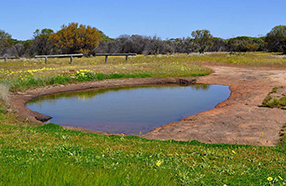
Located 18 kilometres east of Mukinbudin is the Weira Reserve. It boasts a picturesque limestone breakaway with a gnamma hole. There are barbecue, picnic and camping facilities including a toilet. Native flora and fauna abounds. Native orchids may be found on the bush trail and keep an eye out for the Red Capped Robin.
The large gnamma hole like many gnamma holes in the region was an important water source for the Aboriginals, pastoralists who shepherded their sheep throughout the region, miners on route to the goldfields, and sandalwood cutters.
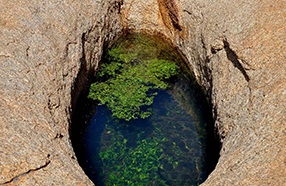
The Wattoning gnamma hole was an important water site for Aborigines. In the late 1800’s two rock lined wells and a soak were constructed by early pastoralists and precious water was carted from these by pastoralists, sandalwood cutters and prospectors. The water was lifted by buckets tied to a rope.
A homestead was constructed in 1873 by James Ward who lived here until about 1890 when it was then inhabited by the Ives Family and then later still by the Hall Family. Both families lost children who are buried in the small graveyard alongside an earlier pioneer. The homestead was then vacant after the tragic death of Mr Hall’s child. Their stories are told on the excellent interpretive signage at the gravesite.
The vacant homestead was then used as a camp by Sandalwooders, who would pull wood in the bush and bring it back to Wattoning for cutting and cleaning. Wattoning homestead was burnt down sometime after 1911. Local Legend has it that some of these men, having too much to drink, became careless and a fire started which quickly gutted the thatched house. At the homestead site there is a picnic table and signage describing life at Wattoning in the early days. There are also the remains of a soak and two wells.
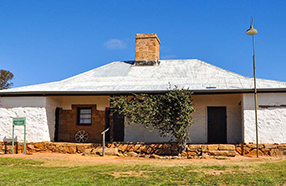
Long a place of hospitality, the Mangowine Homestead is a beautiful historic building built in 1876 and remains a necessary stop for people travelling through the region. Many years ago the homestead provided hospitality for prospectors and other visitors on their way to and from the Eastern Goldfields. It also serviced members of the local community as a place of rest and refreshment on their journeys to other areas. There are sweeping views of the Wheatbelt from the homestead as well as the opportunity to enjoy some renowned country hospitality.
The homestead can be accessed from the Nungarin North Road which runs between Nungarin and Mukinbudin. Enjoy wandering the grounds comprising of 10 hectares of natural bushland and meander through the homestead which has been immaculately restored as a monument to the pioneering Adams family who built and inhabited it. The property consists of the first homestead constructed of stone and mud brick, a wayside inn, cellar, wells and a family store. It also contains interesting items of memorabilia relating to the Adams family. Each room has been restored to its original conditions and is filled with antiques and memorabilia from this era. Mangowine is a historical treasure and will be a highlight of your trip.
Entry Fees:
Adult $4
Students, Pensioners & Concession $2
Family $8
Children & Groups $1 / head
Mangowine Opening Hours:
Monday 1.00 pm – 4.00 pm
Tuesday 1.00 pm – 4.00 pm
Wednesday Closed
Thursday 1.00 pm – 4.00 pm
Friday 1.00 pm – 4.00 pm
Saturday 10.00 am – 4.00 pm
Sunday 10.00 am – 4.00 pm
Public Holidays 10.00 am – 4.00 pm
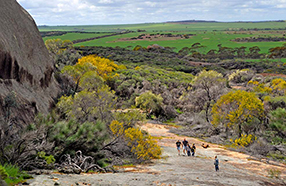
Located on the Trayning Shire’s eastern boundary is the 2,500ha Billycatting Hill Nature Reserve, a nature lover’s paradise, especially during wildflower season. Importantly, the reserve is in pristine condition and exhibits very few signs of human disturbance. The Shire of Trayning, in conjunction with the Department of Environment and Conservation has developed two walk trails and visitor facilities at this excellent nature reserve. There is a 2.4km walk trail that takes explorers on a trail up to the highest point with a trig beacon located at 410m above sea level. The trail has “meet the plants” trail side signs along the way. A reasonable level of fitness is needed as a rock climb is involved. Allow about two hours for the whole walk. Alternatively for those who may prefer a more leisurely stroll there is a 1.1km Woodland Walk Trail through the vegetation at the base of the rock which also has trailside signs about the plants and birdlife. The reserve has picnic facilities, toilets and an interpretive shelter outlining the natural, cultural and historical significance of the reserve. Take a packed lunch and enjoy a great day out with nature, although no camping or dogs are allowed.
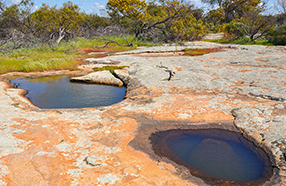
The Trayning Gnammas are located 18km north of Trayning and they are some of the largest in the district. Gnamma’s are the name for watering holes given by the aboriginal people. The Wheatbelt Way region has been home to many Aboriginal groups for millennia, giving it a rich cultural diversity and history. The three main tribal family groups are the Ballardong people (Northam to Wyalkatchem) Kelamaia (out near Mukinbudin to Southern Cross) and the Njaki Njaki (Trayning to Merredin) that tended to congregate around local water holes usually associated with Granite Outcrops, depending on the seasons and conditions.
This site marks the boundary of the Ballardong and Njaki Njaki people and was a source of water for Aboriginal people of the area as they moved from place to place, as well as being a vital water supply for the early explorers and settlers of the district. Birds and other wildlife frequent the area and the perimeters of the granite near the gnammas are good places to search for orchids and wildflowers during the springtime.
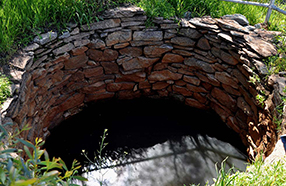
In 1869, John Forrest named the local water source at Trayning, which was his spelling of the local Aboriginal name Duri-iring, a combination of two words meaning to crawl and a camping place. ‘Duranning’ was eventually corrupted to ‘Trayning’. The Aboriginal knowledge of waterholes was essential for early explorer’s and settler’s survival and many soaks and wells retained their Aboriginal name after European settlement.
On 1 March 1879, the Toodyay Road Board accepted the tender of Charles Adams for the sinking of a well at Trayning. In the 1887 survey, the place was described as:
“Good supply of water at present, but not permanent. It is a tank excavated in the ground 10 feet in diameter by 14 feet deep stoned up with stone and covered over with saplings. A small gully is turned into it, which it fills whenever a thunderstorm occurs. This could be improved by enlarging; very good place for a tank.”
The Trayning Well was an important source of water on the Yarragin Road to the Yilgarn Goldfields and for early settlers. Take the time to stop at Trayning Well to admire the workmanship of Charles Adam in the art of sinking and lining a well by hand in the late 1800’s.
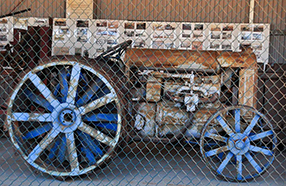
The Yelbeni Town Site Museum is relatively new, having been developed in 2002. It houses a very interesting collection of local history ranging from photos, plaques and pieces of vintage farm machinery that provide an accurate and informative glimpse of the past. Internal access to the museum is available during the Yelbeni Store (located in the original town hall) opening hours where a key can be obtained.
Yelbeni is one of many country towns built around a railway line that had its hey days in the 1920’s. The townsite derives its name from Yelbene Well, a watering point on the Yarragin Road to the Goldfields. In 1934 Yelbeni had one of the first bulk handling wheat bins built at the site behind the Yelbeni Centenary Museum, although it was closed down in the late 1970’s and wheat is now carted to Nembudding or Trayning.

